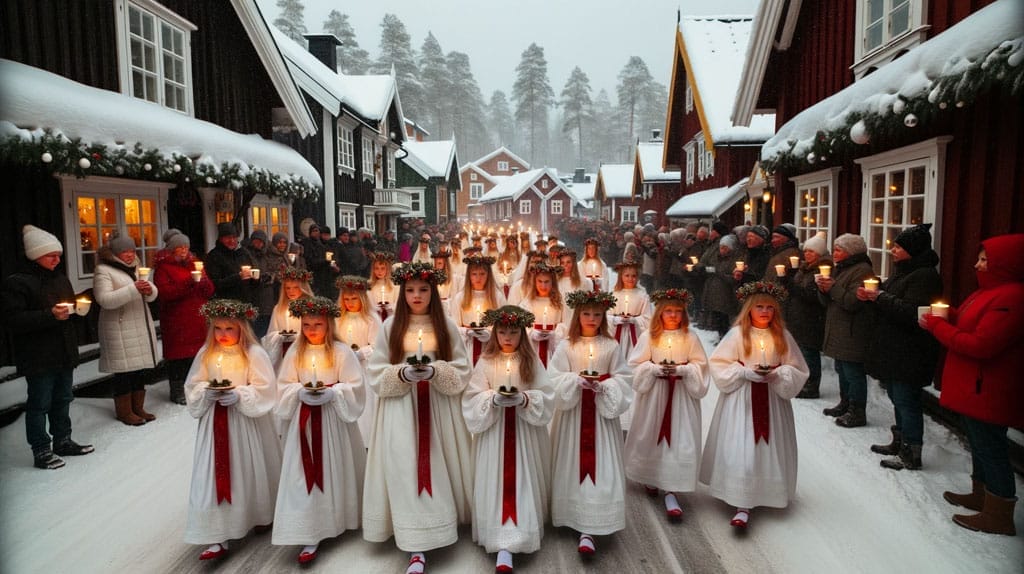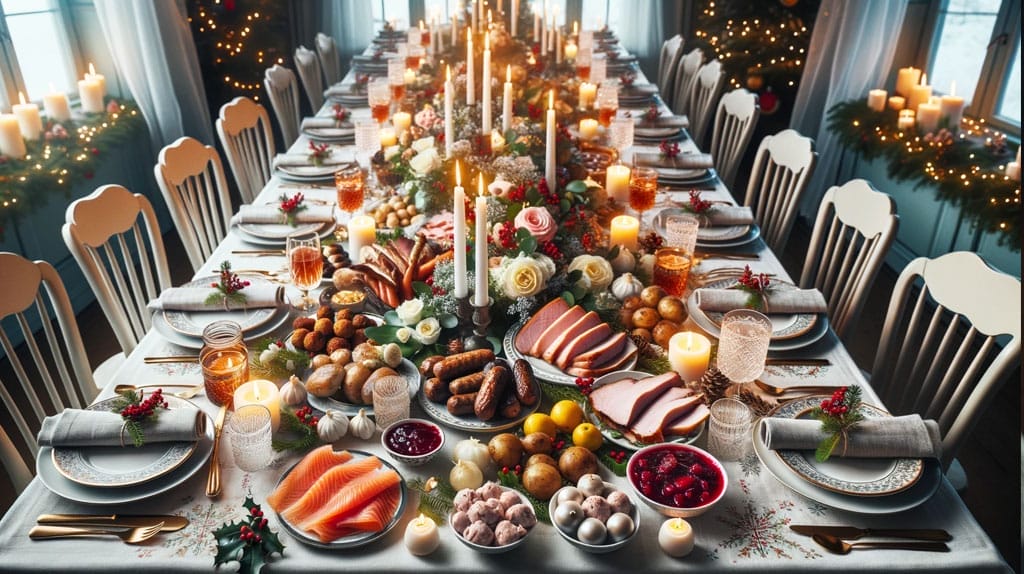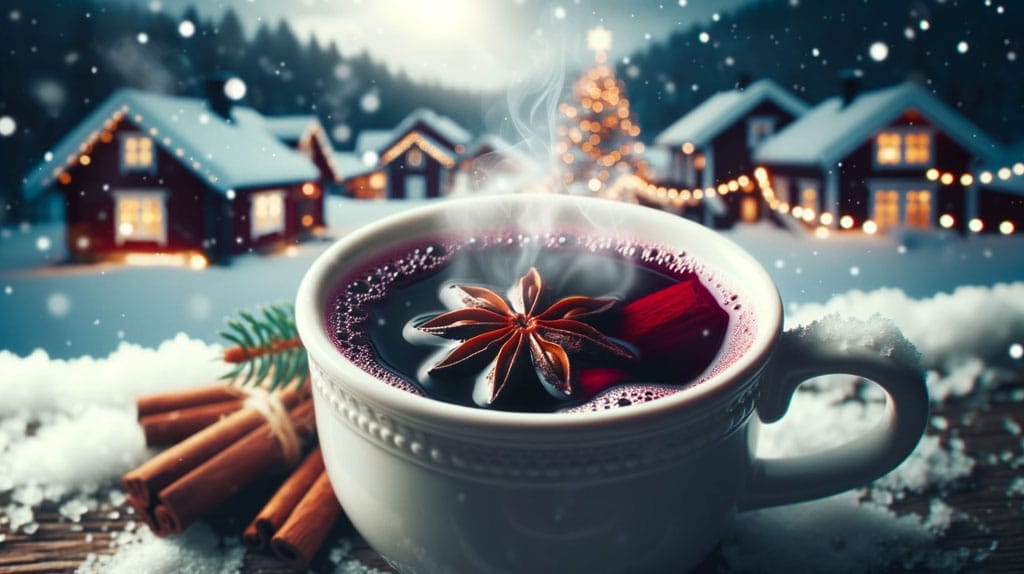Your Guide to Swedish Christmas Traditions

Step into a winter wonderland where sparkling snow blankets the ground, cozy homes radiate with the warm glow of candlelight, and the aroma of mouthwatering dishes fills the air. This is Christmas in Sweden!
The country boasts heartwarming and unique European Christmas traditions that stand out on the global stage. For those eager to learn about festive celebrations done the Swedish way, there’s much to discover. From the enchanting Lucia Day processions to distinctive feasts and delectable sweets, Sweden promises a Christmas experience that lingers in memory.
Key Takeaways:
- Swedish Christmas traditions are deeply rooted in history and folklore.
- You can experience the magic of Lucia Day, Christmas rice porridge, mulled wine, and more.
- Julbord is a grand feast featuring an array of traditional dishes.
- The Star Boys procession brings light to the darkness of winter.
- Advent calendars are a beloved tradition leading up to Christmas.
Nordic Roots: Sweden’s Christmas Traditions
The background of Christmas traditions in Sweden is a rich tapestry woven from a blend of ancient Nordic customs, Christian influences, and more recent global traditions. Long before Christianity reached Scandinavian shores, the Nordic people celebrated the Winter Solstice, a festival known as “Yule.”
This celebration marked the shortest day and longest night of the year, heralding the return of longer days. The burning of the Yule log, feasting on special dishes, and making offerings to Norse gods were all integral parts of this solstice celebration.
As Christianity spread through Europe and eventually to Scandinavia, many of these pagan customs were integrated into Christian observances, laying the foundations for modern Swedish Christmas traditions.
Christian influences brought new layers of significance and ritual to the season. For instance, St. Lucia’s Day, celebrated on December 13th, was introduced as a Christian feast day but soon melded with Nordic traditions to become the festival of light it is today, symbolizing hope and light in the darkest time of the year.
Similarly, the Julbord or Christmas table, though reminiscent of the feasts of old, now includes dishes that are symbolic of Christian stories. Over the years, as Sweden interacted more globally, other influences seeped in, enriching the traditions further. The advent calendar, believed to have German origins, found its way into Swedish homes, adding to the tapestry of festive customs.
Today, Sweden’s Christmas is a beautiful blend of ancient customs, Christian symbolism, and international influences.
Swedish Lucia Day Celebrations
Every December 13th, the Swedish landscape transforms into a realm of shimmering light and melodic song, celebrating Lucia Day. This tradition, deeply anchored in Sweden’s cultural fabric, pays homage to Saint Lucia, a young Christian martyr revered for her boundless kindness and benevolence.
As dawn’s first light pierces the winter sky, the streets come alive with processions led by young girls adorned in white gowns with red sashes, symbolizing purity and sacrifice. These “Lucias” become a beacon of hope, their heads crowned with wreaths of glowing candles.
In homes across Sweden, a familiar scene unfolds. The Lucia, often the eldest daughter, awakens her family, serenading them with traditional carols. She offers them freshly brewed coffee and saffron buns, known as ‘lussekatter’, their golden hue reminiscent of the returning sun.

Accompanying the Lucia are her attendants, often younger girls called “tärnor,” dressed similarly in white, and “stjärngossar,” or star boys, donning white robes, pointed hats, and carrying star-shaped wands.
This festival of light, set against the backdrop of a long Nordic winter, is more than just a visual spectacle. It carries profound symbolism. The candles, burning bright, signify the return of light, hope, and longer days, pushing back against the encroaching darkness of winter.
Lucia Day’s essence transcends its visual beauty, emphasizing the core values of community, generosity, and warmth. It serves as a heartwarming reminder that even in the deepest winter gloom, there’s always a flicker of light, a song of hope, waiting to be kindled.
Advent Calendar Tradition: Counting Down to Christmas
One of the most beloved Swedish Christmas traditions is the advent calendar. These calendars are a special way to count down the days until Christmas.
The advent calendar tradition dates back to the early 1900s in Germany, where families would mark the days of Advent with chalk lines on their doors. By the 1920s, printed Advent calendars had become popular, and soon the tradition spread to Sweden and other parts of Europe.
Today, advent calendars come in many different forms. Some are simple paper calendars with a small chocolate or candy behind each door. Others are more elaborate, with small toys or gifts hidden behind the doors.
In Sweden, a popular type of advent calendar is the “julkalender,” a television series that airs one episode each day leading up to Christmas. Children and families look forward to each new episode and the exciting surprises it brings.
The Advent Stars Tradition
In addition to counting down the days with an advent calendar, many Swedish families also take part in the Advent Stars tradition. This involves hanging up seven-pointed stars in the windows of their homes during the month of December.
The stars are made of paper or straw and are often decorated with glitter and other festive touches. They are meant to symbolize the Star of Bethlehem, which, according to the Bible, guided the Three Wise Men to the baby Jesus.
As you go about your holiday season, consider starting your own advent calendar tradition. Whether you choose a simple paper calendar or a more elaborate version, counting down the days to Christmas is a fun way to get in the holiday spirit.
Christmas Eve Smorgasbord: A Feast to Remember
One of the most beloved Swedish Christmas traditions is the Christmas Eve smorgasbord, or “julbord.” This festive feast is a true culinary delight featuring a wide variety of savory and sweet dishes.
The smorgasbord is typically served on a long table, decorated with holiday-themed linens, candles, and flowers. The meal starts with an assortment of appetizers, including pickled herring, smoked salmon, and other types of fish. These items are traditionally enjoyed with a shot of aquavit, a Scandinavian liqueur.
Next come the hot dishes, such as meatballs, sausages, and ham, often served with potatoes, red cabbage, and lingonberry jam. Some families also serve a traditional Christmas dish called “Jansson’s Temptation,” made with potatoes, onions, cream, and anchovies.

After the hot dishes, it’s time for dessert. Swedish rice pudding, or “risgrynsgröt,” is a popular choice, along with gingerbread cookies and saffron buns. A special soft drink called “Julmust” is often served with the meal.
The smorgasbord is a time for family and friends to gather and enjoy each other’s company, as well as the delicious food. It’s a tradition that has been cherished by Swedes for centuries and continues to be a highlight of the holiday season.
Julbord Feast Dishes: A Grand Swedish Tradition
When it comes to Swedish Christmas traditions, the Julbord feast is one that cannot be missed. This festive culinary tradition is a grand celebration of food and drink, featuring an array of beloved dishes that are sure to delight your taste buds.
Cured Salmon
Cured salmon, or gravlax, is a staple of the Swedish julbord. The salmon is cured with salt, sugar, and dill, creating a sweet and savory flavor that pairs perfectly with crispbread or potatoes. Try it with a dollop of tangy mustard sauce for an extra kick.
Christmas Ham
Christmas ham, or julskinka, is a centerpiece of the julbord feast. The ham is often served cold, with a sweet and spicy mustard glaze. It’s a delicious and hearty addition to the table, and perfect for sandwiches the next day.
Beetroot Salad
Beetroot salad, or rödbetssallad, is a vibrant and flavorful dish that adds some much-needed color to the julbord. The salad is made with diced beets, apples, and onions, dressed with a sweet and tangy vinaigrette. It’s the perfect complement to the rich and savory flavors of the other dishes.
Swedish Meatballs
No julbord feast would be complete without Swedish meatballs, or köttbullar. These savory bites are made with a blend of ground beef and pork, breadcrumbs, and spices, and are typically served with lingonberry sauce. They’re a true Swedish classic, and perfect for snacking on throughout the day.
Boiled Potatoes
Boiled potatoes, or kokt potatis, may sound simple, but they’re an essential part of the julbord feast. They’re typically served with a sprig of dill, and are a perfect vessel for soaking up all the delicious flavors of the other dishes.
These are just a few of the many dishes you’ll find on a Swedish julbord feast. Each family has their own unique traditions and recipes, but one thing is for sure: the julbord feast is a celebration of food, family, and holiday cheer.
Christmas Rice Porridge: Finding the Hidden Almond
If you’re looking for a comforting and delicious holiday treat, look no further than the Swedish tradition of Christmas rice porridge, or “risgrynsgröt”. This creamy and sweet dish is a staple of the Swedish Christmas season and is enjoyed by both young and old alike.
The dish is made with simple ingredients like rice, milk, and sugar, but it’s the addition of a single almond that makes it truly special. According to Swedish folklore, whoever finds the almond in their bowl of rice porridge will have good luck in the coming year.
Traditionally, Christmas rice porridge is served on Christmas Eve and is enjoyed as a dessert or a snack. It’s often served with a dollop of whipped cream and a sprinkle of cinnamon on top. Some families even add a small amount of raspberry or strawberry sauce to their rice porridge for an extra burst of flavor.
Not only is Christmas rice porridge delicious, but it’s also a fun and festive tradition that you can share with your loved ones. So grab a bowl, scoop up some rice porridge, and see if you’re lucky enough to find the hidden almond!
Swedish Mulled Wine: Spiced Warmth for the Holidays
When the chill of winter sets in, there’s nothing quite like a warm and spicy drink to lift your spirits. In Sweden, mulled wine, or “glögg,” is a beloved holiday tradition, bringing comfort and joy to gatherings with family and friends.
The recipe for glögg varies from region to region and family to family, but generally, it consists of red wine, spices like cinnamon and cloves, and sweeteners like sugar or honey. Some recipes also call for fruit, nuts, or spirits like brandy or vodka.

Preparing glögg is a festive ritual in itself. The spices are mixed with the wine and heated gently on the stove, filling the air with the aroma of Christmas. Traditionally, glögg is served in small glasses with raisins and almonds at the bottom, which can be eaten after the drink is finished.
How to Make Swedish Mulled Wine
- Choose a dry red wine, like Cabernet Sauvignon or Merlot.
- Combine the wine with spices like cinnamon sticks, whole cloves, and cardamom pods in a large pot or slow cooker.
- Add sweeteners like sugar, honey, or maple syrup to taste.
- Heat the mixture over low heat, stirring occasionally, until the wine is hot and the flavors are infused. This can take up to an hour.
- Strain the wine and spices through a mesh sieve to remove any solids.
- Serve the glögg in small glasses, with raisins and almonds at the bottom for a sweet surprise.
Whether you’re sipping glögg by a crackling fire or sharing it with loved ones over a festive meal, this Swedish tradition is sure to warm your heart and add a touch of magic to your holiday season.
Saint Stephen’s Day: A Celebration of Charity
As the day after Christmas, December 26th is known in Sweden as “Annandagen,” or Saint Stephen’s Day. While this day is not as widely celebrated as Christmas Eve or Christmas Day, it holds a special place in Swedish tradition as a day of charity and kindness.
Legend has it that Saint Stephen was a deacon in the early Christian church who was stoned to death for his beliefs. In honor of his martyrdom, Swedes use this day as an opportunity to give back to their communities and those in need.
“Annandagen is a day to visit people who may have less fortunate circumstances than ourselves. It is time to share and take care of each other – the true spirit of Christmas,” says Stefan Sundström, a Swedish singer and songwriter.
Many Swedes use this day to volunteer at soup kitchens or homeless shelters, or simply to visit and spend time with elderly or sick neighbors. In some parts of the country, people dress up as “julebukkar,” or Christmas goats, and go door-to-door collecting donations for charity.
Charity Through Food
As with many Swedish traditions, food plays a significant role in Saint Stephen’s Day celebrations. One popular custom is to serve rice porridge, or “risgrynsgröt,” with a hidden almond in the pot. The person who finds the almond in their bowl is said to have good luck for the coming year.
Another traditional dish is sausages served with potatoes and cabbage, known as “stekkor med rotmos.” In some regions, Saint Stephen’s Day is also a time to enjoy leftover Christmas ham or other festive foods from the day before.
Whether it’s through volunteering, donating to charity, or simply sharing a meal with a neighbor, Saint Stephen’s Day is a reminder of the importance of generosity and compassion during the holiday season.
FAQ
What are some typical Swedish Christmas traditions?
Some typical Swedish Christmas traditions include celebrating Lucia Day on December 13th, enjoying a Christmas Eve smorgasbord feast, making saffron buns, participating in the Star Boys procession, and counting down to Christmas with advent calendars.
What is Lucia Day and why is it celebrated in Sweden?
Lucia Day is celebrated on December 13th in Sweden. It involves a procession of young girls wearing white gowns and candles in their hair, symbolizing Saint Lucia. This day is celebrated to bring light and hope during the dark winter season.
What is a Christmas Eve smorgasbord?
A Christmas Eve smorgasbord is a festive feast in Sweden that includes a variety of traditional dishes such as pickled herring, gravlax, meatballs, sausages, and more. It is a time for family and friends to gather and enjoy a plentiful meal together.
How can I make saffron buns?
To make saffron buns, you will need saffron, flour, sugar, butter, milk, yeast, and raisins. There are various recipes available online that provide step-by-step instructions on how to make these delicious Swedish treats.
What is the Star Boys procession?
The Star Boys procession is a Swedish Christmas tradition where young boys dress as “star boys” and go door-to-door singing carols while carrying stars. It is a symbolic way of spreading light and joy during the holiday season.
What is the advent calendar tradition in Sweden?
The advent calendar tradition in Sweden involves counting down the days to Christmas with a small surprise behind each door or window of a calendar. It can be chocolates, small gifts, or other treats, adding excitement and anticipation during December.
What is Saint Stephen’s Day in Sweden?
Saint Stephen’s Day, known as “Annandagen” in Sweden, is a day to celebrate acts of charity and kindness. It is a time to reflect the spirit of the holiday season by helping others and spreading goodwill.
What is Christmas rice porridge?
Christmas rice porridge, also known as “risgrynsgröt,” is a traditional Swedish dish eaten during the holiday season. It is a creamy rice pudding made with rice, milk, and a touch of cinnamon. A hidden almond is often included, and finding it brings good luck.
What is Swedish mulled wine?
Swedish mulled wine, known as “glögg,” is a spiced and warm beverage enjoyed during the winter holidays. It is typically made with red wine, spices like cinnamon and cloves, and sweetened with sugar. It adds a cozy and festive touch to the celebrations.
What is the Julbord feast in Sweden?
The Julbord feast is a grand Swedish tradition featuring an abundance of delicious dishes served during the Christmas season. It includes items like cured salmon, Christmas ham, beetroot salad, and many other delicacies. It is a time for indulgence and celebration.




